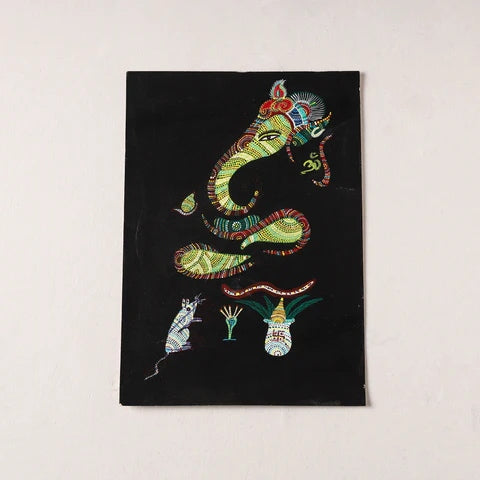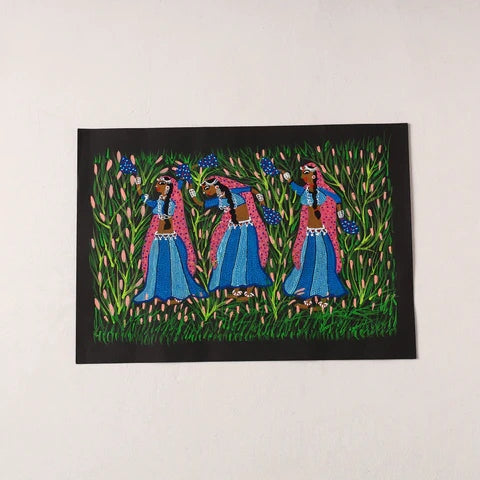The art form of Central India
Bhil art is simple and elemental, the result of long-standing ties to nature.The Bhils are one of the largest indigenous communities in India, mainly found in the states of Madhya Pradesh, Rajasthan, Gujarat, and Maharashtra. Although the history of Bhil art is unclear, it is estimated to trace back to centuries. Over time, Bhil paintings have grown from a purely domestic art tradition to a more popular art form.The fact that the art has been passed down through generations, with the majority of painters learning it from their mothers, makes it all the more distinctive.
Pleasant elements of Bhil paintings
Bhil paintings are typically created on walls, floors, and cloth using natural colours derived from leaves, flowers, and rocks. The Bhil artists make their paintings with a wide range of natural pigments. Different things, like flowers, leaves, roots, and stones, are used to make these colours. For example, geru, a type of clay, is used to make red pigment, and the healer of all, haldi, is used to make yellow pigment.
Bhil painters also use a special method called "dor," in which a segment of string dipped in paint is used to draw the outline of a painting. With this method, the painting has a unique textured look.
Overall, Bhil painting is known for its use of natural materials and earthy colours, which show how close the Bhil people are to nature. 
Make your own Bhil Painting
The majority of Bhil paintings represent the daily life, religious and mythical beliefs, and cultural customs of the Bhil community. Simple geometric patterns, wildlife, and human figures are typically shown in the folk-art style of the Bhil paintings. Here's how you can make your own Bhil art:
- Choose your surface. Traditionally, Bhil art is done with natural pigments on the walls of homes. But you can make Bhil art on paper, canvas, fabric, or any other surface.
- Get your materials ready. Bhil art is made with natural pigments that come from plants and stones. By grinding up things like charcoal, turmeric, and indigo, you can make your own colours.
- Draw your design. Most Bhil art is based on the natural world and has bold, geometric patterns. Make a light sketch of your design on your surface with a pencil.
- Once you have a sketch of your design, you can start painting with a brush or your fingers. Lovely bright colours are used in Bhil art, so don't be afraid to use bright colours yourself.
- Add details: Once you've filled in the main parts of your design, you can add dots, lines, and swirls for more intricate details. These details can help give your Bhil art piece more texture and depth.
- Let your Bhil art piece dry completely before putting it on display. You can protect your art by spraying it with a fixative or putting it in a frame.
- Remember that Bhil art is an old form of art that takes time and practise to learn. Let your creativity and imagination lead you as you paint to make beautiful Bhil art.

Bhil and Gond belong to the same domain?
Two types of Indian folk art exist: the Bhil style and the Gond style. Although there are some parallels between the two styles—both are considered to be tribal art—there are also significant differences:
The Gond tribe of Madhya Pradesh, India, and the Bhil group, one of the largest indigenous communities in India, are responsible for the development of the art forms of Bhil and Gond painting, respectively.
Generally, Gond paintings feature black as the major colour and bright colours like red, yellow, and blue to highlight certain sections of the painting, whereas Bhil paintings use a wide spectrum of colours to produce a colourful and bold aesthetic.
Bhil paintings are characterised by their minimalist brushwork and geometric forms, whereas Gond paintings are distinguished by the intricate patterns they create with dots and lines.
While many contemporary Bhil painters still work primarily with natural colours obtained from stones and plants, they also work with more accessible mediums such as paper and canvas. Although many Gond painters still choose to work on the walls of their homes, many have adapted to the modern era by painting on paper and canvas with artificial colours.

So, the design motifs, primary colours, technique, and medium of Bhil painting and Gond painting distinguish them as two different schools of Indian folk art. All are examples of tribal art, yet each displays the unique characteristics of the groups who produce it.

In summary, Bhil painting and Gond painting are two distinct styles of Indian folk paintings that have their unique characteristics, including design elements, primary colours, technique, and medium. While both styles are tribal art forms, they reflect the individuality and cultural diversity of the communities that create them.
Framing the Fame of Bhil
Bhuri Bai, as the first woman artist from the Bhil community to paint on paper, has made significant contributions to the field of art and culture in India and was awarded with a Padma Shri. At a young age, she was inspired by the vibrant colours of a local festival to start painting, and soon she was painting laughing deities and scenes from her own village. She learned to make cottages from her mother, and the cows that became a trademark of her art are a homage to the skills she was taught. Her mud paintings, which she began in childhood, now grace the walls of Bhopal's Museum of Mankind, which she helped establish in her adult years.

By receiving the Padma Shri award, Bhuri Bai's contributions to the art world and her efforts to promote the cultural heritage of the Bhil community have been recognized and celebrated. This award will not only bring her much-deserved recognition but will also inspire and encourage other artists and members of indigenous communities to preserve and promote their traditional art forms.
Currently, several Bhil painters create paintings on paper and canvas with modern techniques and materials. Many art collectors and aficionados appreciate the distinctive beauty and cultural relevance of Bhil art, which has earned recognition both within India and beyond.
blogs you might also like
Meenakari: a world of Colors, Stories and Traditions
Bandhani saree: the most celebrated attire from the land of Gujarat
Famous handicrafts of India from 29 States and UTs
 Verified Purchase
Verified Purchase
























Leave a comment (all fields required)